- Home
- Courses
- Cinema Exhibition Training
- Training for Non-Technical Cinema Employees
A Look At Light – Part I
Pictures are complicated. Moving pictures on the screen are more complicated.
The act of seeing pictures on the screen seems easy, but seeing with judgement is also complicated.
Objective: To learn enough so that we can help keep the picture’s quality up to its potential.
Why? Because customers come to you,
- they expect that you will understand their complaints and
- they expect you to report what they saw so that it can be fixed. They don’t want to return and have the same problem.
It will be even better if you are able to walk into an auditorium and know how to see problems, and report them before they are seen by anyone else!
Pictures are made of colors.
For this lesson, we are going to say that even black and white are colors. Why? Because every color can be darker or lighter, until they are either black or white. Black and white are the extremes of the range of darkness and lightness for each color.
For example, inside the deep forest we will see deep greens that go to almost black. We will also see bright green moss or leaves with moisture that are closer to white. The same is true of brick red and pink cherry ice cream or the deep blue suit of an executive and the light blue scarf that she is wearing.
Color scientists could turn that previous section into books of information about intensity and hue and many other interesting topics. But we need to stay focused (just like a picture should stay focused, but Focus is in another lesson.)
Colors can be pure, which we shall call chromatic – because that is what the science people call them. …and they use the word since it has been nearly the same since the early greeks used it for both music and color.

But, as we said, they change as white or black is added to them. Here is a picture of that black and white, with a range of all the other colors of grey in between:
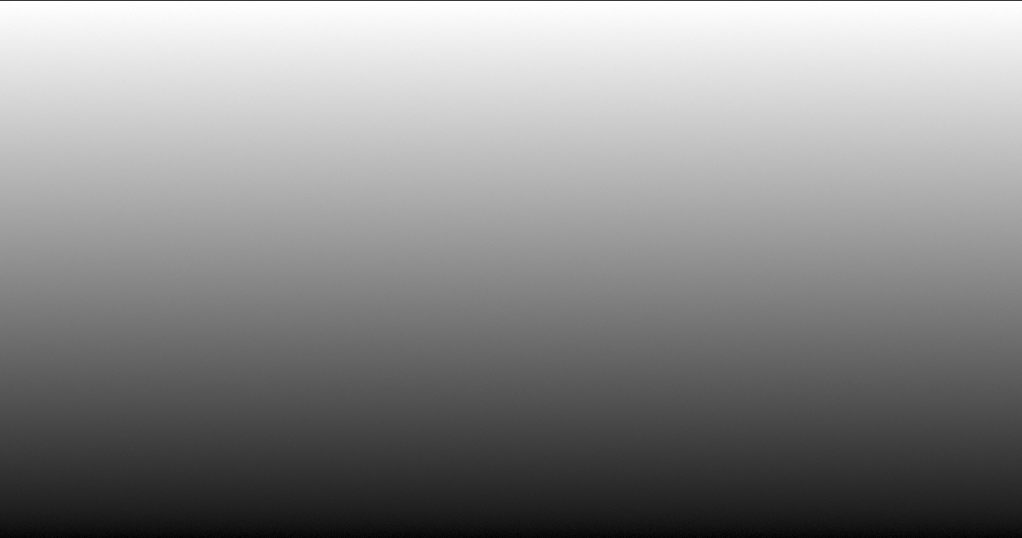
And this is what we get when we put them together:
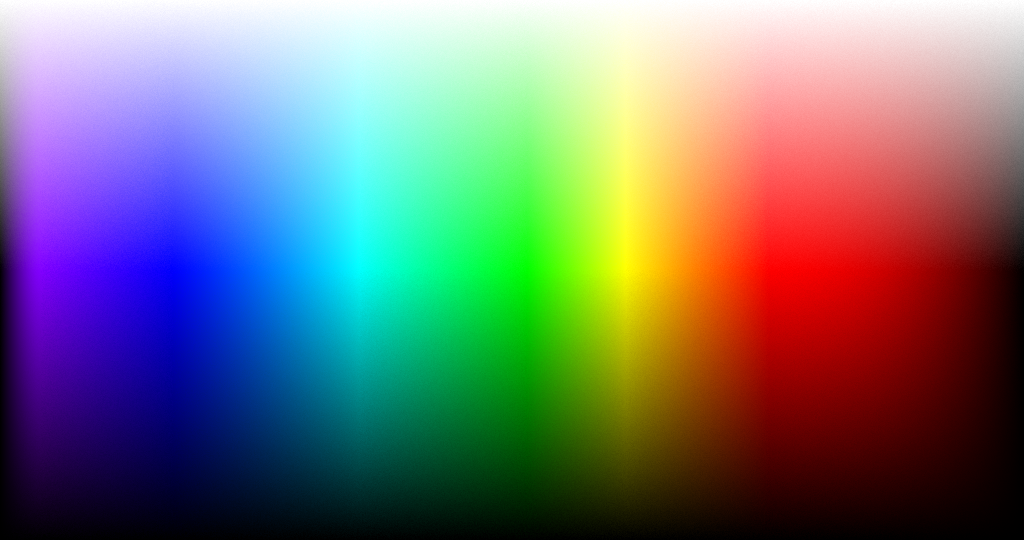
There is more to be said about this, but we will save that for the lesson about the Human Visual System. Definitely nothing there that you need to know. It is just fun stuff.
The Purpose of Looking At Light
Our purpose is to understand what is happening on the screen when it is hit with light. We don’t really need to know the science of the eyes, but we need to understand the different ways that the eyes can be affected.
Why? So that we can tell if the picture on the screen is good or bad, or better or best. …or worse or worst.
A Whole Chain of Things
As we dive into the science, the first thing that we find are that there is a name for everything. Names are the first layer. Then we learn the differences between the words, these names.
For example, we are actually only interested in what the audience can see from the projection system. That seems so simple. Just two things: the audience and the projection system. We can tell the tech, “The audience member said there was something wrong with the movie’s projection.”
So what that really means that we are interested in the projector (1), and the screen (2) which bounces the light (reflection) (3) and the eyes (4) that see the light (with some ability to judge). We probably don’t need to know too much about the projector, except that it has a lens (5) that may need cleaning and focusing. If we know what to look for, we can tell the technician more detail, where to look for the solution to the problem.
Oh, and the port glass (6) in front of the lens, in case it needs cleaning – which happens much more often. It also needs regular cleaning on the inside, or it will make an incredible picture on the back wall of the projection booth.
And we should know a little about the screen which also may need cleaning – or replacing if it gets too old and yellow instead of white. Of course, there are different kinds of screens, and each kind has special cleaning techniques – you can ruin a screen if you clean it in the way that is only correct for a different kind of screen.
There are two kinds of lights (7) in the auditorium as well. The service lights that are turned on after the audience leaves, and the automated lights that get darker and brighter before and after the movie – hopefully.
Hopefully, because if we continue to be interested in what our audience sees, we should know that all these items affect color (8) and brightness (9) and contrast (10) – which means we probably actually should know a bit about the eyes. Because, if there is one thing that can be fooled by colors and brightness and contrast, it is the eyes. So, we better end up studying them a little. But, later. OK?
Touching Science
As we figured out in other lessons, one fact about science is that there is a particular name for everything. That complicates things at first, but it takes complication away after the names are learned.
When we were in school, we learned that the front of the eye has a lens, and that the back of the eye is made up of a special kinds of cells which have a special capability. These cells can sense the differences between different kinds of light.
That is not so weird really. We have nerves that can sense the difference in pressure, and nerves that can sense the difference in heat. Some nerves can sense moisture, and other things that the nerves of the skin and muscles can sense). Move you fingers lightly against the back of your other hand. You can feel cold or warmth perhaps, and the increase or decrease in pressure. Is there moisture? Is there an itch or tickle? That is the effect of nerves.
We also have nerves that can sense the difference between salty and sweet tastes (and the other tastes that the nerves on the tongue can sense).
Seeing Science
The back of the eye is called the retina. The retina is covered with 125 million of these light sensing cells, and many other things. In the next YouTube video the person calls these nerves neurons. Neuron is the name for a type of cell at the end of a nerve. Some neurons tell a muscle what to do. The neurons that we are interested in are the neurons that can sense light and dark and color.
The typical eye has about 120 million neurons that help us only when it is getting dark. The other 5 or 6 million are sensitive to green (about 3.5 to 4 million), red (1.5 million) and blue light (a few hundred thousand).
Sit back, and watch this video about how the eyes use 3 different sensors to get the sensation of color into the brain.
A lot of information there. Watch it a 2nd time. Then watch it again tomorrow.
We don’t work with Wavelength a lot in life, so it isn’t as easy as grabbing a mouse or using a touchpad. Remember our lessons in Sound – The examples said that Wavelength is the distance between the peaks of the waves. Is there more power in the longer distance or the shorter?
Let’s look at another quick video that covers the same information in a different way.
What is he talking about, Minus Green? How weird. Ah – that reminds us that there is no such thing as color anyway. It is all in the mind.
Color Models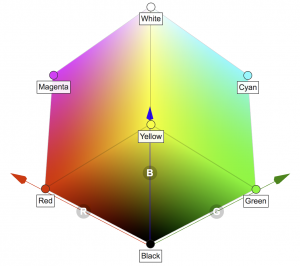
Click on this link for a very interesting site and journey into the topic of color. Wigglepixel “What are Color Models?” explains colors with interactive tools.
Just a clue so that you can be certain while you dig into this information: Projectors work in the RGB system. Another clue. Take your time with this. Go paragraph by paragraph, then ask yourself what is interesting. Ask yourself if there is anything that you can use. Ask yourself if there is anything still confusing – if confusing, read it again and look for words or symbols that you don’t know. …or maybe there is something earlier that is confusing and words that are not understood. Look the words up, see where they were derived from, and use them in your head for a while, then go back to the text and examples.
Don’t just buzz through this site one time. Even though the explanation tries to be simple, each paragraph is filled with information that has a lot of important connections that may not be obvious. Nuance everywhere~! Watch it once, then play around with the graphics to get used to them. Then later, go back again later and concentrate on just one of the sections. Translate Mystery to Knowledge until you can work with it without thinking it through each time.
See if this is something to share with friends. Fun Science.
When we see a picture on the screen, we are actually seeing 24 separate pictures every second…or 25 pictures per second in Europe and other parts of the world. And since we are seeing digital cinema from digital projectors, we are actually seeing digital pictures.
What the heck does that mean, digital pictures?
If we go a few steps back in the chain before the pictures hit the screen, we can see that the picture went through a piece of glass – called the port glass – and then we see it coming out of a lens. Very expensive that lens, but film projectors used lenses and port glass too. So that isn’t what makes them digital.
What makes them digital is just before that. There are 3 electronic chips made of thousands and thousands of very tiny mirrors that respond to the information coming from the media player. The media player is really just a computer playing a huge file. In a way, it is like a Blu Ray player, which is also a computer, but which is designed to play the files from a Blu Ray Disc. The cinema player plays a file from several hard disks at the same time.
The information from the hard disks goes to the projector. The projector focuses a ton of light onto these magic chips. Most companies use these chips with mirrors, so we will describe that next.
Imagine being able to reflect light with some mirrors. Now, imagine those mirrors are so tiny that you can fit millions of them into one small computer chip. Now imagine that you can control them so fast that they move to the angle you want them to move to a hundred times a second. Now, imagine one chip is being flooded with red light, one chip with blue light, and one chip with green light, and those millions of mirrors are crazily pointing little dots of red and blue and green light to the lens, or away from the lens. Now, imagine that they are so coordinated that the colors combine to make faces and fountains and butterflies appear on the screen.
OK; you can imagine that. I prefer to think of it as magic, but let’s not argue. (Some people will swear that it is science.)
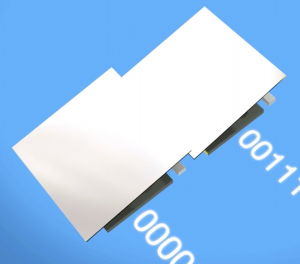
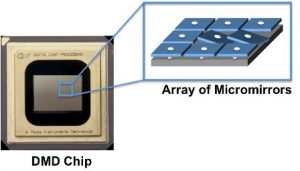
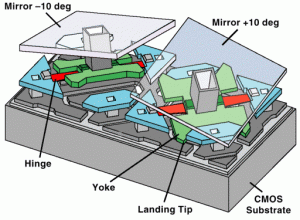
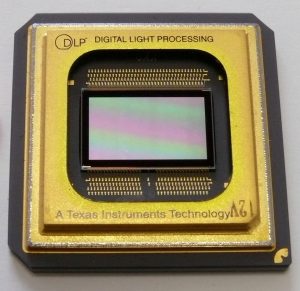
The projectors in your room, Barco, Christie and NEC, all use Texas Instruments DLP (Digital Light Projection) DMDs (Digital Micromirror Devices). Many theaters use Sony projectors – they use a slightly different kind of magic that does something similar, but with crystals.
And that is what makes it a digital device. The pictures in the computer file are made of computer code that are made of ones and zeros…a one makes the mirror go one direction (to point light through the lens), and the zero makes the mirror point to a giant hole of magic blackness where tiny little creatures watch the same movie we see, only seeing the opposite.
Meanwhile, back on the screen. We know that red light and green light will create yellow light. A little less green (or more red) and we see brown then orange, and a little more green (or less red) and we see lighter then more intense shades of green. Different combinations of red and green and blue give us a very wide range of colors to see. In fact, there are billions of combinations that make billions of colors.
If we combine all three colors equally with all the energy we can deliver, the colors join to make white. Make the energy less intense but keeping the amounts of red and green and blue equal, and we get a shade of grey. As the energy gets less, the greys go down to black.
If we slightly change the proportion of red and green and blue, that grey color will shift. We will be able to see a pink or yellow or greenish ‘cast’ in the grey.
But this is where the eyes and nerves and brain and memory get involved with seeing a picture. Because we know what a blue sky is, what red signs should be, what white and green should be. And when we see a bright white cloud appearing on the screen we can be pretty certain that this a very very bright white!
Except it isn’t. The brightest white that we see in the cinema theater is hundreds, and even thousands of times less bright than what we see outside when we see a blue sky and a bright pool bathed in sunlight. Our human visual system tries to make things better for us. Which is sometimes a good thing. Because if the system didn’t do that, we would not think that the bright white in a cinema theater was very interesting…but we do. Yet, more magic.
Let’s take a break here, watch a little movie, then go out in the world and discover what we have learned. This movie is a talk by a guy named Beau Lotto that gives us a different way of seeing that there is a difference between reality and perception. In this case, we are partial experts since we know that there is no color, just light bouncing off of things – the important part is how our visual system interprets these things.
Finally, a fun video that shows how movies were shown before they came from digital files – it teaches many lessons: How You See It (1936)
And that is the background for Part Two of A Look at Light. As always, spend a few days looking at things – on the screen and off – that are part of understanding what is discussed here. Then go to the next lesson.